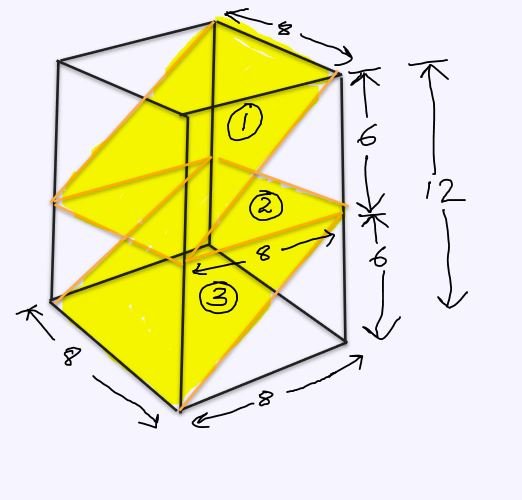tkorzhan1995 I hope the figure attached will help you to understand this question better.
Note: If you could visualize a 3D figure based on the information's given and understand what area we need to find here, solving this question would be easier.
We have a rectangular box, whose base is a square with a side of 8 inches and whose height is 12 inches. A single rectangular sheet ( Yellow shaded region in the attached figure ) is folded twice to form two identical diagonal planes, one at each end, and a horizontal plane in the middle so that the box is divided into four identical compartments. We are asked to find the area of the rectangular insert.
Please refer to the figure attached for the 3D -view and we are asked to find the yellow shaded region in the figure.
Attachment:
 3D_FIGURE.JPG [ 38.36 KiB | Viewed 8738 times ]
3D_FIGURE.JPG [ 38.36 KiB | Viewed 8738 times ]
Let's cut the entire rectangular insert into three parts: Sheets 1,2 and 3 as marked in the figure. The width of each sheet will be the same i.e 8 inches.
Since the box is divided into 4 identical compartments, the height of each compartment will be 12/2 = 6 inches.
The length of rectangular sheet 1 will be the hypotenuse of the right-angled triangle formed as shown in the figure with a base of 8 inches and a height of 6 inches.
Length of sheet 1 = Sq.root(\(8^2 + 6^2\)) = 10 inches
Area of Sheet 1 = 10 * 8 = 80 sq. inches
It's given in the question that Sheet 1 and Sheet 3 are two identical diagonal planes, hence their area will also be the same i.e 80 sq. inches.
Sheet 2 will be a square of base 8 cm, hence the area of sheet 2 = 8 * 8 = 64 sq. inches
Area of rectangular insert = Area of Sheet 1 + Area of sheet 2 + Area of sheet 3= 80 + 64 + 80 = 224 sq. inches.
Option B is the correct answer.Thanks,
Clifin J Francis,
GMAT Mentor

 75%
(hard)
75%
(hard)
 41%
(02:40)
wrong
41%
(02:40)
wrong  based on 766
sessions
based on 766
sessions